IBPS PO - Anatomy of flowering plant 1000+ MCQ [Solved] PDF Download
Thursday 9th of March 2023

Sharing is caring
1. Match column-I with column-II and select the correct option from the codes given below.
A. A IV, B I, C II, D III
B. A III, B II, C I, D IV
C. A I, B II, C III, D IV
D. A IV, B II, C I, D III
Answer : A
| Column-I | Column-II |
|---|---|
| A. Stele | I. Innermost layer of cortex |
| B. Endodermis | II. Suberin |
| C. Casparian strips | III. All the tissues exterior to vascular cambium |
| D. Bark | IV. All the tissues inner to endodermis |
A. A IV, B I, C II, D III
B. A III, B II, C I, D IV
C. A I, B II, C III, D IV
D. A IV, B II, C I, D III
Answer : A
2. Which of the following statement(s) is/are not correct?
A. (iii) and (iv)
B. (i) and (ii)
C. (ii) and (iii)
D. (ii) and (iv)
Answer : A
- Cork cambium is also called phellogen.
- Cork is also called phellem.
- Secondary cortex is also called periderm.
- Cork cambium, cork and secondary cortex are collectively called phelloderm.
A. (iii) and (iv)
B. (i) and (ii)
C. (ii) and (iii)
D. (ii) and (iv)
Answer : A
3. Various functions like photosynthesis, storage, excretion performed by _____________.
A. sclerenchyma
B. parenchyma
C. collenchyma
D. aerenchyma
Answer : B
A. sclerenchyma
B. parenchyma
C. collenchyma
D. aerenchyma
Answer : B
4. Which one of the followings option shows the correct labelling of the parts marked as A, B, C and D in the given figure a lenticel?
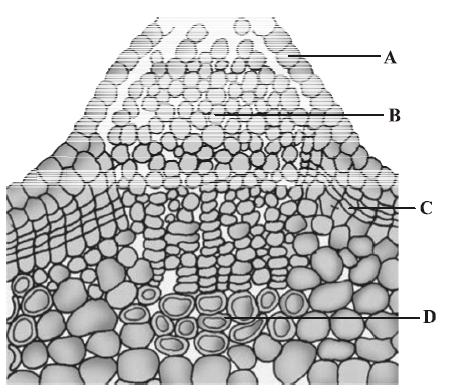
A. A Epidermis, B Secondary cortex, C Cork cambium, D Cork
B. A Pore, B Cork cambium, C Secondary cortex, D Cork
C. A Pore, B Cork, C Complimentary cells, D Cork cambium
D. A Epidermis, B Complimentary cells, C Cork cambium, D Secondary cortex
Answer : D

A. A Epidermis, B Secondary cortex, C Cork cambium, D Cork
B. A Pore, B Cork cambium, C Secondary cortex, D Cork
C. A Pore, B Cork, C Complimentary cells, D Cork cambium
D. A Epidermis, B Complimentary cells, C Cork cambium, D Secondary cortex
Answer : D
5. The given diagrams show stomatal apparatus in dicots and monocots. Which one is correct option for A, B and C?

A. A Epidermal cells; B Subsidiary cells; C chloroplast
B. A Guard cells; B Subsidiary cells; C Stomatal pore
C. A Guard cells; B Epidermal cells; C Guard cells
D. A Epidermal cells; B Subsidiary cells; C Guard cells
Answer : D

A. A Epidermal cells; B Subsidiary cells; C chloroplast
B. A Guard cells; B Subsidiary cells; C Stomatal pore
C. A Guard cells; B Epidermal cells; C Guard cells
D. A Epidermal cells; B Subsidiary cells; C Guard cells
Answer : D
6. A common structural feature of vessel elements and sieve tube elements are
A. pores on lateral walls.
B. presence of p-protein.
C. enucleate condition.
D. thick secondary walls.
Answer : C
A. pores on lateral walls.
B. presence of p-protein.
C. enucleate condition.
D. thick secondary walls.
Answer : C
7. Which meristem helps in increasing girth?
A. Lateral meristem
B. Intercalary meristem
C. Primary meristem
D. Apical meristem
Answer : A
A. Lateral meristem
B. Intercalary meristem
C. Primary meristem
D. Apical meristem
Answer : A
8. Cork is formed from
A. phellogen
B. vascular cambium
C. phloem
D. xylem
Answer : A
A. phellogen
B. vascular cambium
C. phloem
D. xylem
Answer : A
9. Which of the following process helps the trichomes in preventing water loss?
A. Where companion cells helps in maintaining the pressure gradient in the sieve tubes.
B. Where plants absorb water through the roots and then give off water vapor through pores in their leaves.
C. Where activity of cork cambium builds pressure on the remaining layers peripheral to phellogen and ultimately these layers dies and slough off.
D. None of the above
Answer : B
A. Where companion cells helps in maintaining the pressure gradient in the sieve tubes.
B. Where plants absorb water through the roots and then give off water vapor through pores in their leaves.
C. Where activity of cork cambium builds pressure on the remaining layers peripheral to phellogen and ultimately these layers dies and slough off.
D. None of the above
Answer : B
10. In an experiment, a student cut a transverse section of young stem of a plant which he has taken from his school garden.
After observing it under the microscope how would he ascertain whether it is a monocot stem or a dicot stem?
A. With the help of bulliform cells.
B. With the help of casparian strips.
C. With the help of vascular bundles.
D. With the help of stomatal apparatus.
Answer : C
After observing it under the microscope how would he ascertain whether it is a monocot stem or a dicot stem?
A. With the help of bulliform cells.
B. With the help of casparian strips.
C. With the help of vascular bundles.
D. With the help of stomatal apparatus.
Answer : C
11. One of the primary function of the ground tissue in a plant is
A. photosynthesis.
B. to protect the plant.
C. to anchor the plant.
D. water and sugar conduction.
Answer : A
A. photosynthesis.
B. to protect the plant.
C. to anchor the plant.
D. water and sugar conduction.
Answer : A
12. Cells of permanent tissues are specialized
A. functionally.
B. only structurally.
C. both structurally and functionally.
D. for mitosis.
Answer : C
A. functionally.
B. only structurally.
C. both structurally and functionally.
D. for mitosis.
Answer : C
13. In stems, the protoxylem lies towards the _____________ and the metaxylem lies towards the ____________ of the organ.
A. centre; periphery
B. periphery; centre
C. periphery; periphery
D. centre; centre
Answer : A
A. centre; periphery
B. periphery; centre
C. periphery; periphery
D. centre; centre
Answer : A
14. A student was given a tissue to observe under the microscope. He observes the tissue and concludes that the tissue is a type of simple plant tissue and provides mechanical support to young stem and petiole of leaf.
Identify the tissue.
A. Parenchyma
B. Collenchyma
C. Sclerenchyma
D. Xylem parenchyma
Answer : B
Identify the tissue.
A. Parenchyma
B. Collenchyma
C. Sclerenchyma
D. Xylem parenchyma
Answer : B
15. The given figure shows the secondary growth in a dicot stem. Their parts are marked as A, B, C, D, E & F. Choose the correct labelling of the parts marked as A to F.

A. A Phellem, B Phellogen, C Medullary rays, D Secondary xylem, E Secondary phloem, F Cambium ring
B. A Phellem, B Phellogen, C Medullary rays, D Secondary phloem, E Secondary xylem, F Cambium ring
C. A Phellogen, B Phellem, C Medullary rays, D Secondary xylem, E Secondary phloem, F Cambium ring
D. A Phellem, B Phellogen, C Cambium ring, D Secondary xylem, E Secondary phloem, F Medullary rays
Answer : A

A. A Phellem, B Phellogen, C Medullary rays, D Secondary xylem, E Secondary phloem, F Cambium ring
B. A Phellem, B Phellogen, C Medullary rays, D Secondary phloem, E Secondary xylem, F Cambium ring
C. A Phellogen, B Phellem, C Medullary rays, D Secondary xylem, E Secondary phloem, F Cambium ring
D. A Phellem, B Phellogen, C Cambium ring, D Secondary xylem, E Secondary phloem, F Medullary rays
Answer : A
16. Match the followings and choose the correct option
A. A III, B IV, C I, D II
B. A I, B II, C III, D IV
C. A III, B II, C IV, D I
D. A III, B II, C I, D IV
Answer : A
| Column-I | Column-II |
|---|---|
| A. Cuticle | |
| B. Bulliform cells | II. Outer layer |
| C. Stomata | III. Waxy layer |
| D. Epidermis | IV. Empty colourless cell |
A. A III, B IV, C I, D II
B. A I, B II, C III, D IV
C. A III, B II, C IV, D I
D. A III, B II, C I, D IV
Answer : A
17. Sclerenchyma usually___________and_____________ protoplasts.
A. live, without
B. dead, with
C. live, with
D. dead, without
Answer : D
A. live, without
B. dead, with
C. live, with
D. dead, without
Answer : D
18. A tissue is a group of cells which are
A. similar in origin, but dissimilar in form and function.
B. dissimilar in origin, form and function.
C. dissimilar in origin, but similar in form and function.
D. similar in origin, form and function.
Answer : D
A. similar in origin, but dissimilar in form and function.
B. dissimilar in origin, form and function.
C. dissimilar in origin, but similar in form and function.
D. similar in origin, form and function.
Answer : D
19. Bast fibres are made up of _____________cells.
A. sclerenchymatous
B. chlorenchymatous
C. parenchymatous
D. aerenchymatous
Answer : A
A. sclerenchymatous
B. chlorenchymatous
C. parenchymatous
D. aerenchymatous
Answer : A
20. T.S. of monocot leaf is given below, certain parts have been marked by alphabets (A G). Which one is the option showing there correct labelling?
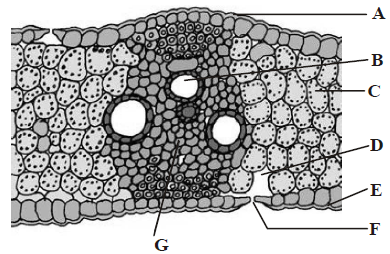
A. A Adaxial epidermis, B Xylem, C Mesophyll, D Sub-stomatal cavity, E Abaxial epidermis, F Stoma, G Phloem
B. A Adaxial epidermis, B Abaxial epidermis, C Xylem, D Sub-stomatal cavity, E Stoma, F Mesophyll, G Phloem
C. A Adaxial epidermis, B Phloem, C Mesophyll, D Sub-stomatal cavity, E Abaxial epidermis, F Xylem, G Stoma
D. A Adaxial epidermis, B Xylem, C Stoma, D Substomatal cavity, E Abaxial epidermis, F Phloem, G Mesophyll
Answer : A

A. A Adaxial epidermis, B Xylem, C Mesophyll, D Sub-stomatal cavity, E Abaxial epidermis, F Stoma, G Phloem
B. A Adaxial epidermis, B Abaxial epidermis, C Xylem, D Sub-stomatal cavity, E Stoma, F Mesophyll, G Phloem
C. A Adaxial epidermis, B Phloem, C Mesophyll, D Sub-stomatal cavity, E Abaxial epidermis, F Xylem, G Stoma
D. A Adaxial epidermis, B Xylem, C Stoma, D Substomatal cavity, E Abaxial epidermis, F Phloem, G Mesophyll
Answer : A
21. Which of the following is responsible for the formation of an embryonic shoot called axillary bud?
A. Lateral meristem
B. Apical meristem
C. Intercalary meristem
D. Both
Answer : C
A. Lateral meristem
B. Apical meristem
C. Intercalary meristem
D. Both
Answer : C
22. Apical and intercalary meristems are primary meristems because
A. they occur in the mature region of roots and shoots of many plants.
B. they made up of different kinds of tissues.
C. they involved in secondary growth.
D. they appear early in life of a plant and contribute to the formation of the primary plant body.
Answer : D
A. they occur in the mature region of roots and shoots of many plants.
B. they made up of different kinds of tissues.
C. they involved in secondary growth.
D. they appear early in life of a plant and contribute to the formation of the primary plant body.
Answer : D
23. Read the following statements and answer the question.
Which plant anatomy is being described by the above statements?
A. Dicotyledonous root
B. Monocotyledonous root
C. Dicotyledonous stem
D. Monocotyledonous stem
Answer : D
- It has a sclerenchymatous hypodermis, a large number of scattered vascular bundles and a large parenchymatous ground tissue.
- Vascular bundles are conjoint and closed.
- Peripheral vascular bundles are generally smaller than the centrally located ones.
- Phloem parenchyma is absent, and water- containing cavities are present within the vascular bundles.
Which plant anatomy is being described by the above statements?
A. Dicotyledonous root
B. Monocotyledonous root
C. Dicotyledonous stem
D. Monocotyledonous stem
Answer : D
24. Trees at sea do not have annual rings because
A. soil is sandy.
B. there is climatic variation.
C. there is no marked climatic variation.
D. there is enough moisture in the atmosphere.
Answer : C
A. soil is sandy.
B. there is climatic variation.
C. there is no marked climatic variation.
D. there is enough moisture in the atmosphere.
Answer : C
25. The length of different internodes in a culm of sugarcane is variable because of
A. size of leaf lamina at the node below each internode
B. intercalary meristem
C. shoot apical meristem
D. position of axillary buds
Answer : B
A. size of leaf lamina at the node below each internode
B. intercalary meristem
C. shoot apical meristem
D. position of axillary buds
Answer : B
26. Identify the types of simple tissue indicated by A, B, C and D and their function.
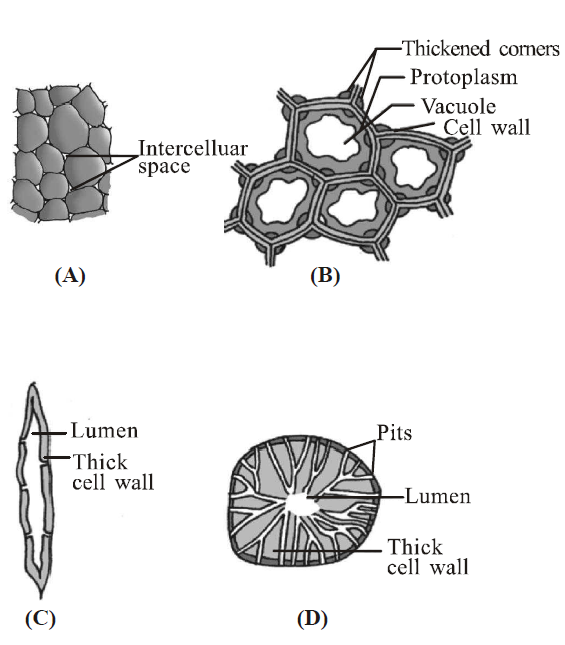
A. A Parenchyma, Photosynthesis, Storage and Secretion.
B. B Sclerenchyma Scleriods; Transport food material
C. C Collenchyma; Provides mechanical support to organs.
D. D Sclerenchyma Fibres; Provide Mechanical support to the growing parts of the plant such as young stem and petiole of a leaf.
Answer : A

A. A Parenchyma, Photosynthesis, Storage and Secretion.
B. B Sclerenchyma Scleriods; Transport food material
C. C Collenchyma; Provides mechanical support to organs.
D. D Sclerenchyma Fibres; Provide Mechanical support to the growing parts of the plant such as young stem and petiole of a leaf.
Answer : A
27. Match the terms given in column I with their features given in column II and choose the correct option.
A. A - (i), B - (ii), C - (iii), D - (iv), E - (v)
B. A - (iii), B - (v), C - (ii), D - (iv), E - (i)
C. A - (iii), B - (i), C - (v), D - (ii), E - (iv)
D. A - (v), B - (iv), C - (iii), D - (i), E - (ii)
Answer : B
| Column-I | Column-II |
|---|---|
| (Terms) | (Features) |
| A. Fibres | (i) Cells are living and thin walled with cellulosic cell wall, store food materials in the form of starch or fat |
| B. Sclereids | (ii) Main water conductive cells of the pteridophytes and the gymnosperms |
| C. Tracheids | (iii) Thick walled, elongated and pointed cells, generally occurring in groups |
| D. Vessels | (iv) Long cylindrical tube like structure and cells are devoid of protoplasm. Characteristic feature of angiosperms |
| E. Xylem parenchyma | (v) Reduced form of sclerenchyma cells with highly thickened lignified cellular walls that form small bundles of durable layers of tissue in most plants. |
A. A - (i), B - (ii), C - (iii), D - (iv), E - (v)
B. A - (iii), B - (v), C - (ii), D - (iv), E - (i)
C. A - (iii), B - (i), C - (v), D - (ii), E - (iv)
D. A - (v), B - (iv), C - (iii), D - (i), E - (ii)
Answer : B
28. Main function of lenticel is
A. transpiration
B. guttation
C. gaseous exchange
D. both (a) & (c)
Answer : A
A. transpiration
B. guttation
C. gaseous exchange
D. both (a) & (c)
Answer : A
29. Which of the following statement(s) is/are correct ?
A. (i) and (iv) only
B. (ii) and (v) only
C. (iii) and (iv) only
D. (ii), (iii) and (v) only
Answer : D
- Uneven thickening of cell wall is characteristic of sclerenchyma.
- Periblem forms cortex of the stem and the root.
- Tracheids are the chief water transporting elements in gymnosperms.
- Companion cell is devoid of nucleus at maturity.
- The commercial cork is obtained from Quercus suber.
A. (i) and (iv) only
B. (ii) and (v) only
C. (iii) and (iv) only
D. (ii), (iii) and (v) only
Answer : D
30. Match the terms given in column I with their funciton given in column II and chose the correct option.
A. A I, B III, C V, D II, E IV
B. A III, B I, C II, D V, E IV
C. A II, B IV, C V, D I, E III
D. A V, B IV, C III, D II, E I
Answer : B
| Column-I | Column-II |
|---|---|
| (Term) | (Functions) |
| A. Meristem | I. Photosynthesis, storage |
| B. Parenchyma | II. Mechanical support |
| C. Collenchyma | III. Actively dividing cells |
| D. Sclerenchyma | IV. Stomata |
| E. Epidermal tissue | V. Sclereids |
A. A I, B III, C V, D II, E IV
B. A III, B I, C II, D V, E IV
C. A II, B IV, C V, D I, E III
D. A V, B IV, C III, D II, E I
Answer : B
31. The given figure shows apical meristem of root apex with few part marked as A, B and C. Identify the correct labelling of A, B and C.
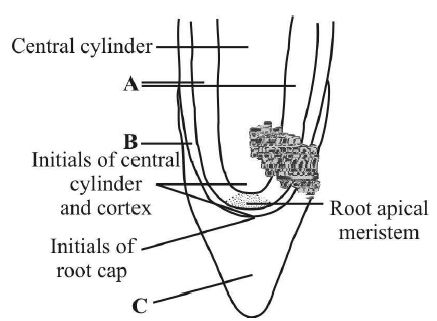
A. A Vascular structure, B Protoderm, C Root cap
B. A Cortex, B Endodermis, C Root cap
C. A Cortex, B Protoderm, C Root cap
D. A Tunica, B Protoderm, C Root cap
Answer : C

A. A Vascular structure, B Protoderm, C Root cap
B. A Cortex, B Endodermis, C Root cap
C. A Cortex, B Protoderm, C Root cap
D. A Tunica, B Protoderm, C Root cap
Answer : C
32. The apical meristem of the root is present
A. in all the roots.
B. only in radicals.
C. only in tap roots.
D. only in adventitious roots.
Answer : A
A. in all the roots.
B. only in radicals.
C. only in tap roots.
D. only in adventitious roots.
Answer : A
33. Cork cambium and vascular cambium are
A. the parts of secondary xylem and phloem.
B. the parts of pericycle.
C. lateral meristems.
D. apical meristems.
Answer : C
A. the parts of secondary xylem and phloem.
B. the parts of pericycle.
C. lateral meristems.
D. apical meristems.
Answer : C
34. A vascular bundle in which the protoxylem is pointing to the periphery is called __________.
A. endarch
B. exarch
C. radial
D. closed
Answer : B
A. endarch
B. exarch
C. radial
D. closed
Answer : B
35. Which of the following figure is a type of permanent tissue having many different types of cell?
A.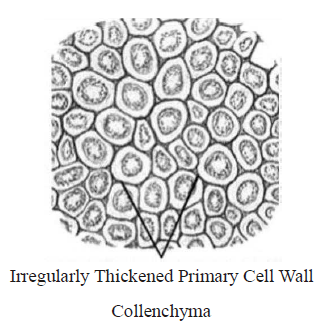
B.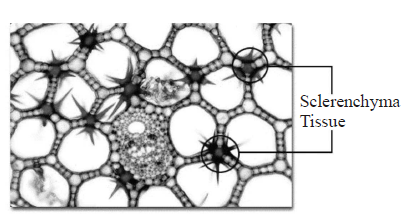
C.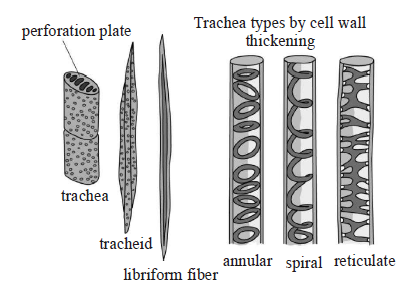
D.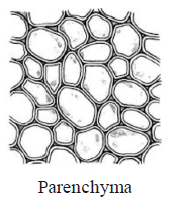
Answer : C
A.

B.

C.

D.

Answer : C
36. In land plants, the guard cells differ from other epidermal cells in having
A. cytoskeleton.
B. mitochondria.
C. endoplasmic reticulum.
D. chloroplasts.
Answer : D
A. cytoskeleton.
B. mitochondria.
C. endoplasmic reticulum.
D. chloroplasts.
Answer : D
37. Some vascular bundles are described as open because these
A. are surrounded by pericycle but not endodermis.
B. are capable of producing secondary xylem and phloem.
C. possess conjunctive tissue between xylem and phloem.
D. are not surrounded by pericycle.
Answer : B
A. are surrounded by pericycle but not endodermis.
B. are capable of producing secondary xylem and phloem.
C. possess conjunctive tissue between xylem and phloem.
D. are not surrounded by pericycle.
Answer : B
38. Match the elements of xylem given in column I with their character given in the column II and choose the correct option.
A. A IV; B III; C II; D I
B. A III; B II; C I; D IV
C. A II; B I; C IV; D III
D. A III; B IV; C II; D I
Answer : D
| Column-I | Column-II |
|---|---|
| A. Xylem vessels | I. Store food materials |
| B. Xylem tracheids | II. Obliterated lumen |
| C. Xylem fibres | III. Perforated plates |
| D. Xylem parenchyma | IV. Chisel-like ends |
A. A IV; B III; C II; D I
B. A III; B II; C I; D IV
C. A II; B I; C IV; D III
D. A III; B IV; C II; D I
Answer : D
39. A narrow layer of thin walled cells found between phloem/ bark and wood of a dicot is
A. cork cambium
B. vascular cambium
C. endodermis
D. both (a) & (c)
Answer : B
A. cork cambium
B. vascular cambium
C. endodermis
D. both (a) & (c)
Answer : B
40. The given figure shows T.S. of monocot stem. Identify the correct labelling of A to F marked in the given figure.
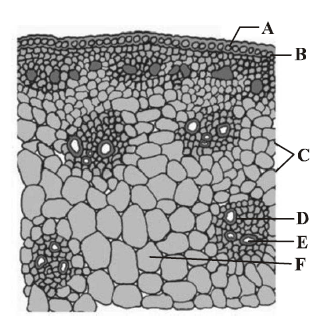
A. A Epidermis, B Hypodermis, C Vascular bundles, D Phloem, E Xylem, F Ground tissue
B. A Cuticle, B Epidermis, C Sclerenchymatous sheath, D Sclerenchymatous hypodermis, E Parenchymatous sheath, F Phloem
C. A Cuticle, B Epidermis, C Sclerenchymatous hypodermis, D Sclerenchymatous sheath, E Parenchymatous sheath, F Phloem
D. A Cuticle, B Epidermis, C Sclerenchymatous hypodermis, D Sclerenchymatous sheath, E Parenchymatous sheath, F Protoxylem
Answer : A

A. A Epidermis, B Hypodermis, C Vascular bundles, D Phloem, E Xylem, F Ground tissue
B. A Cuticle, B Epidermis, C Sclerenchymatous sheath, D Sclerenchymatous hypodermis, E Parenchymatous sheath, F Phloem
C. A Cuticle, B Epidermis, C Sclerenchymatous hypodermis, D Sclerenchymatous sheath, E Parenchymatous sheath, F Phloem
D. A Cuticle, B Epidermis, C Sclerenchymatous hypodermis, D Sclerenchymatous sheath, E Parenchymatous sheath, F Protoxylem
Answer : A
41. Match column-I with column-II and choose the correct option.
Which of the following combination is correct ?
A. A II, IV, VII, VIII; B I, III, V, VI
B. A I, II, VII, VIII; B III, IV, V, VI
C. A I, III, V, VI; B II, IV, VII, VIII
D. A I, III, VII, VIII; B II, IV, V, VI
Answer : C
| A. Spring wood or | I. Lighter in colour early wood |
|---|---|
| B. Autumn wood or | II. High density late wood |
| .. | III. Low density |
| .. | IV. Darker in colour |
| .. | V. Larger number of xylem elements |
| .. | VI. Vessels with wider cavity |
| .. | VII. Lesser number of xylem elements |
| .. | VIII. Vessels with small cavity |
Which of the following combination is correct ?
A. A II, IV, VII, VIII; B I, III, V, VI
B. A I, II, VII, VIII; B III, IV, V, VI
C. A I, III, V, VI; B II, IV, VII, VIII
D. A I, III, VII, VIII; B II, IV, V, VI
Answer : C
42. Which of the following statements is correct?
A. Lenticels occur in most woody trees.
B. Sclerenchymatous cells are usually present in cortex.
C. The vascular tissue system is divided into three main zones- cortex, pericycle and pith.
D. The conjoint vascular bundles usually have the xylem located only on the outer side of the phloem.
Answer : A
A. Lenticels occur in most woody trees.
B. Sclerenchymatous cells are usually present in cortex.
C. The vascular tissue system is divided into three main zones- cortex, pericycle and pith.
D. The conjoint vascular bundles usually have the xylem located only on the outer side of the phloem.
Answer : A
43. Match column-I with column-II and choose the correct option.
A. A III, B V, C IV, D I, E II
B. A II, B V, C I, D III, E IV
C. A II, B IV, C I, D III, E V
D. A III, B I, C V, D II, E IV
Answer : D
| Column -I | Column -II |
|---|---|
| A. Bulliform cells | I. Initiation of lateral roots |
| B. Pericycle | II. Root |
| C. Endarch xylem | III. Grasses |
| D. Exarch xylem | IV. Dicot leaf |
| E. Bundle sheath cells | V. Stem |
A. A III, B V, C IV, D I, E II
C. A II, B IV, C I, D III, E V
D. A III, B I, C V, D II, E IV
Answer : D
44. When we peel the skin of a potato tuber, we remove
A. periderm
B. epidermis
C. cuticle
D. leaves
Answer : A
A. periderm
B. epidermis
C. cuticle
D. leaves
Answer : A
45. Match the names of the structures given in column-I with the functions given in column-II, choose the answer which gives the correct combination of the two columns :
A. A V, B III, C I, D IV
B. A I, B IV, C V, D III
C. A II, B IV, C I, D III
D. A IV, B I, C III, D V
Answer : D
| Column-I | Column-II |
|---|---|
| (Structure) | (Function) |
| A. Stomata | I. Protection of stem |
| B. Bark | II. Plant movement |
| C. Cambium | III. Secondary growth |
| D. Cuticle | IV. Transpiration |
| V. Prevent the loss of water | ... |
A. A V, B III, C I, D IV
B. A I, B IV, C V, D III
C. A II, B IV, C I, D III
D. A IV, B I, C III, D V
Answer : D
46. T.S. of dicot stem is given below, certain parts have been marked by alphabets (A I). Choose the option which shows their correct labelling.

A. A Epidermis, B Epidermal hair, C Parenchyma, D Starch sheath, E Hypodermis (collenchyma), F Vascular bundle, G Bundle cap, H Medulla or pith, I Medullary rays
B. A Epidermal hair, B Epidermis, C Hypodermis (collenchyma), D Parenchyma, E Endoderm is (Starch Sheath), F Pericycle, G Vascular bundle, H Medullary rays, I Medulla or pith
C. A Epidermal hair, B Epidermis, C Hypodermis (collenchyma), D Starch sheath, E Parenchyma, F Vascular bundle, G Bundle cap, H Medulla or pith, I Medullary rays
D. A Epidermal hair, B Epidermis, C Parenchyma, D Hypodermis (collenchyma), E Starch sheath, F Vascular bundle, G Bundle cap, H Medulla or pith, I Medullary rays
Answer : B

A. A Epidermis, B Epidermal hair, C Parenchyma, D Starch sheath, E Hypodermis (collenchyma), F Vascular bundle, G Bundle cap, H Medulla or pith, I Medullary rays
B. A Epidermal hair, B Epidermis, C Hypodermis (collenchyma), D Parenchyma, E Endoderm is (Starch Sheath), F Pericycle, G Vascular bundle, H Medullary rays, I Medulla or pith
C. A Epidermal hair, B Epidermis, C Hypodermis (collenchyma), D Starch sheath, E Parenchyma, F Vascular bundle, G Bundle cap, H Medulla or pith, I Medullary rays
D. A Epidermal hair, B Epidermis, C Parenchyma, D Hypodermis (collenchyma), E Starch sheath, F Vascular bundle, G Bundle cap, H Medulla or pith, I Medullary rays
Answer : B
47. An organised and differentiated cellular structure having cytoplasm but no nucleus is called _________.
A. vessels
B. xylem parenchyma
C. sieve tubes
D. tracheids
Answer : C
A. vessels
B. xylem parenchyma
C. sieve tubes
D. tracheids
Answer : C
48. Which of the following are present in monocot root ?
A. conjoint, collateral, open polyarch vascular bundle.
B. exodermis, endarch, tetrarch closed vascular bundles.
C. suberized exodermis, casparian strip, passage cells, cambium.
D. suberized exodermis, polyarch xylem, pith.
Answer : D
A. conjoint, collateral, open polyarch vascular bundle.
B. exodermis, endarch, tetrarch closed vascular bundles.
C. suberized exodermis, casparian strip, passage cells, cambium.
D. suberized exodermis, polyarch xylem, pith.
Answer : D
49. Why grafting is successful in dicots ?
A. In dicots vascular bundles are arranged in a ring.
B. Dicots have cambium for secondary growth.
C. In dicots vessels with elements are arranged end to end.
D. Cork cambium is present in dicots
Answer : B
A. In dicots vascular bundles are arranged in a ring.
B. Dicots have cambium for secondary growth.
C. In dicots vessels with elements are arranged end to end.
D. Cork cambium is present in dicots
Answer : B
50. During the formation of leaves and elongation of stem, some cells left behind from the shoot apical meristem, constitute the
A. lateral meristem
B. axillary bud
C. cork cambium
D. fascicular cambium
Answer : B
A. lateral meristem
B. axillary bud
C. cork cambium
D. fascicular cambium
Answer : B
Sharing is caring
Related Post
1000+ Computer Fundamental MCQ for UPSC CSE [Solved]
Networking 1000+ MCQ with answer for UPSC CSE
Relationship based problems 1000+ MCQ with answer for CEED
Kidney cysts and tumors MCQ Solved Paper for FCI Recruitment
1000+ Idioms & Phrases MCQ for RRB ALP [Solved]
RBI Grade B officer - Operating System 1000+ MCQ [Solved] PDF Download